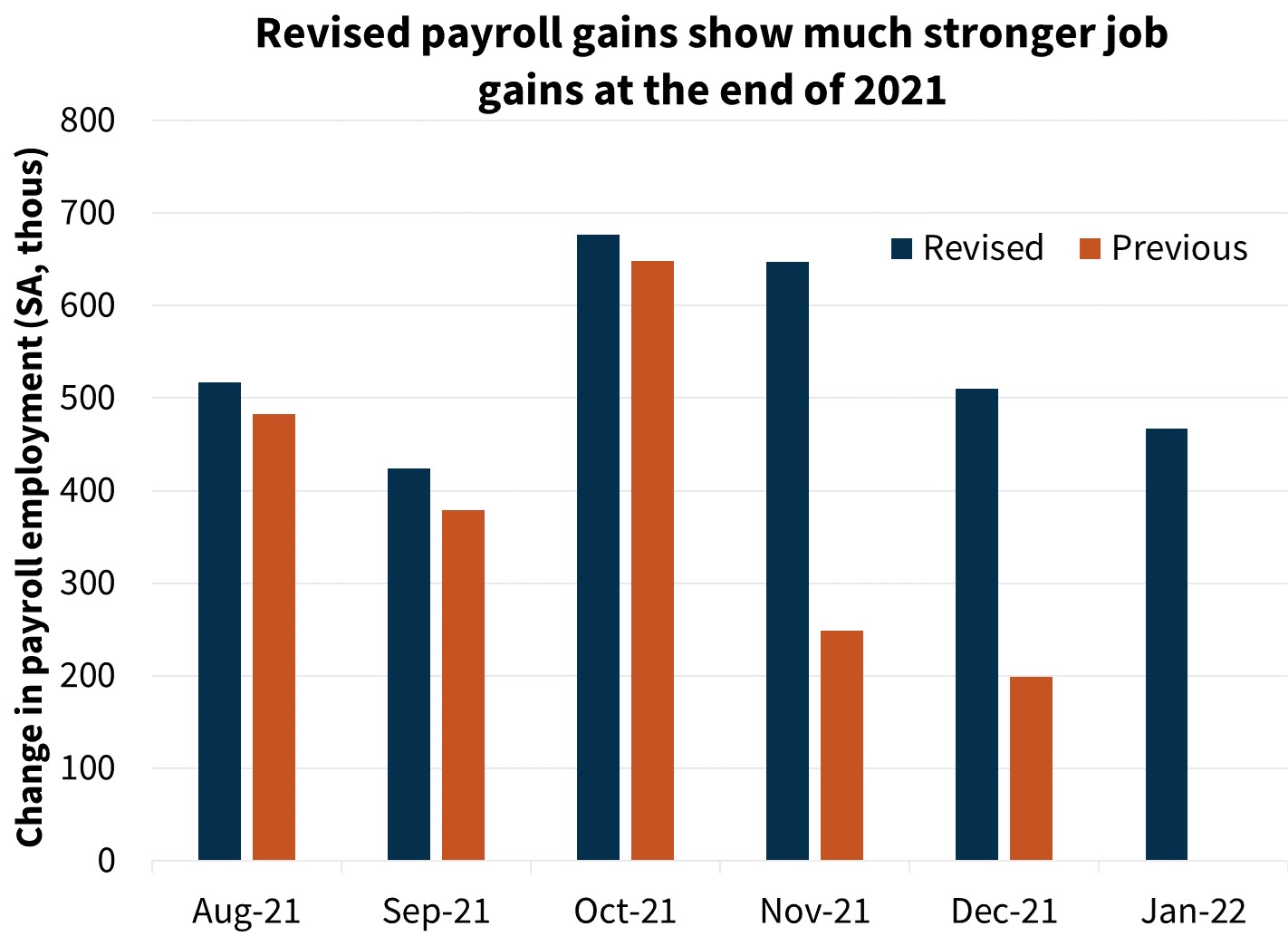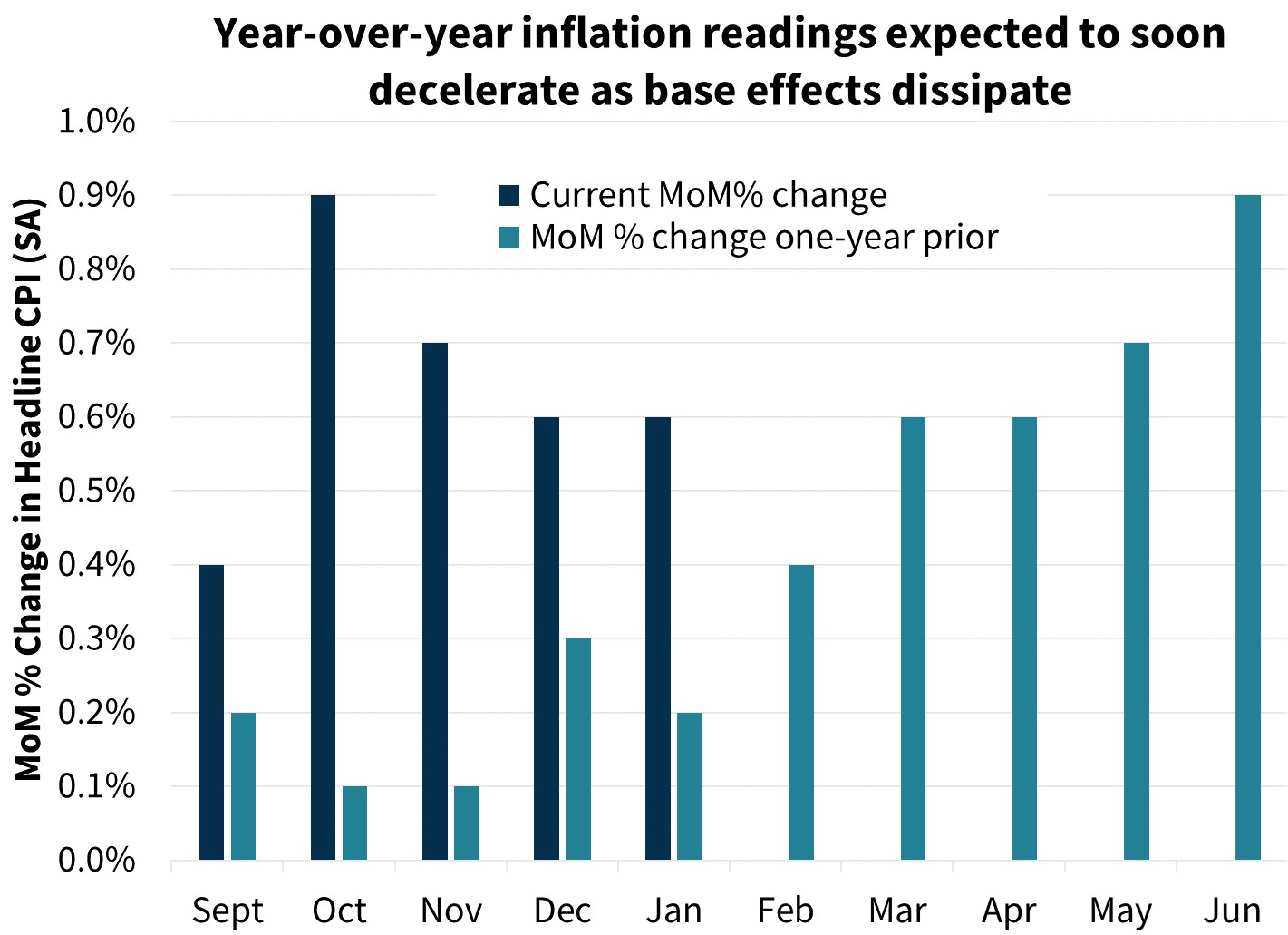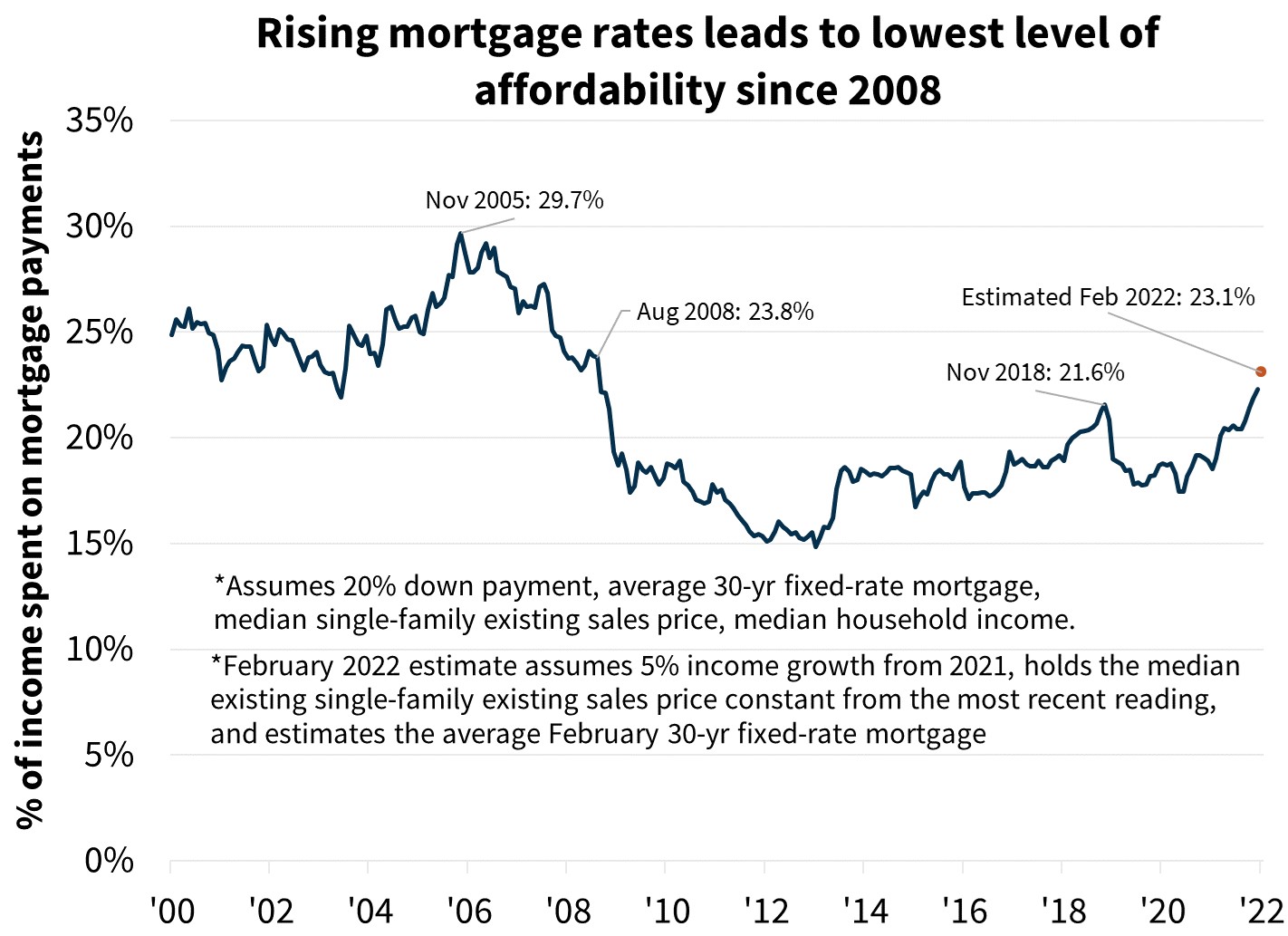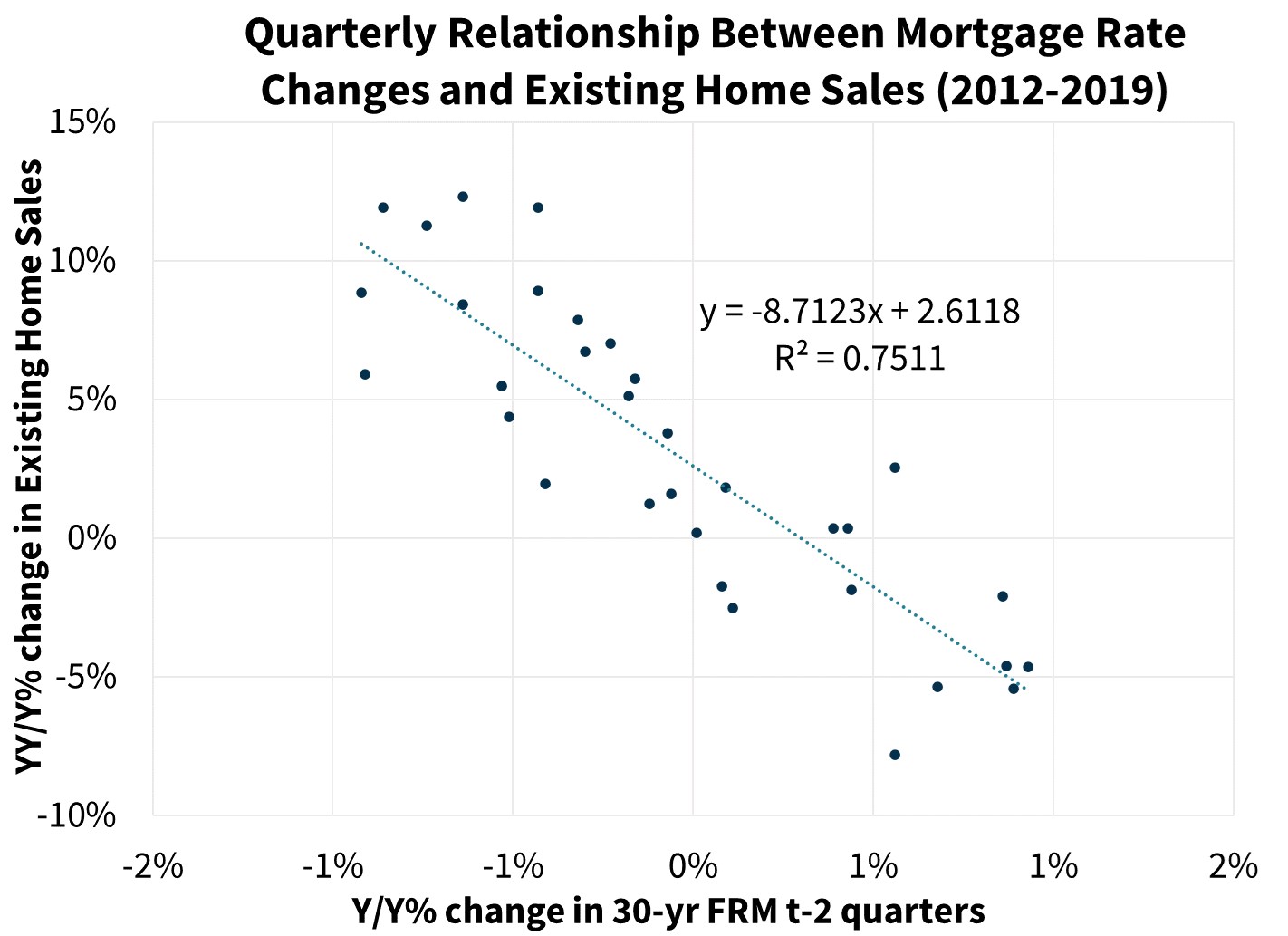Interest Rates on the Move as Inflation Hits New High
Inflation continues to accelerate, hitting a new forty-year high in January. As a result, the Federal Reserve looks poised to begin a more aggressive tightening policy than previously anticipated. We now expect a 50-basis point hike to occur in March, the beginning of a multi-year tightening period through 2023. With the market having similar expectations, long-run interest rates have moved up meaningfully over the past month and are now approaching pre-COVID levels. These developments, including a major revision to last year’s employment data suggesting there is less labor market slack than previously thought, has led us to downgrade our 2022 real gross domestic product (GDP) outlook. Additionally, in part due to the underlying details of the Q4 2021 GDP release, we now expect a greater deceleration in the current quarter. We have downwardly revised our 2022 GDP outlook to 2.8 percent from 3.1 percent on a Q4/Q4 basis, while maintaining our 2023 projection of 2.2 percent, a pace near long-run trend growth.
A higher interest rate outlook along with modestly slower economic growth also led to a downward revision to our housing outlook. We now expect home sales to decline 2.4 percent in 2022 (previously -1.2 percent) in part due to increasing affordability constraints as rising mortgage rates and house price appreciation to date act to cool demand in coming quarters. We still expect strong new home sales and construction as homebuilders work through current supply chain difficulties. However, affordability will likely weigh on this segment as well. We forecast single-family mortgage originations to total $3.2 trillion in 2022 and to total $2.9 trillion in 2023, down from our previous forecast of $3.4 trillion and $3.1 trillion, respectively.
We note that our interest rate forecast was completed at the start of February, prior to the most recent roughly 20-basis point upward move in the 10-year Treasury yield. Therefore, there is substantial upside risk to our published interest rate outlook, as well as some downside risk to our housing and mortgage originations forecast. Additionally, as of this writing, changing geopolitical developments in Eastern Europe have led to significant daily swings in interest rates and oil prices, also pointing to heightened risk to our interest rate and inflationary outlooks. We are also assuming that the Omicron COVID-19 wave is soon to pass and that the virus, in one form or another, will have negligible economic impact moving forward.
Growth Is Decelerating Significantly
Fourth quarter 2021 GDP growth came in at a strong 6.9 percent annualized rate, which is likely to mark the peak pace going forward. The overall figure was in line with our previous forecast, but the details were significantly different from our expectations. Growth was driven almost entirely by a surge in inventory restocking, which is “borrowing from the future.” This will have to be made up for in Q1 2022 as the pace of further inventory building slows. In contrast “real final sales,” meaning consumption and fixed investment over the period, rose by a much weaker 1.9 percent annualized in Q4. This much slower underlying trend, combined with rising inflation eating into real household incomes, an expiration of the extended child tax credit payments to start the year, and Omicron related disruptions in January, will likely lead to Q1 GDP slowing markedly from Q4 2021. We’ve downwardly revised our expectation for the quarter to just 1.3 percent annualized growth from a previous 3.4 percent, though we expect a short term rebound in Q2.
Additionally, the annual benchmarking revision for the employment data series saw major changes to last year’s readings. The update revealed that the pace of job growth was much stronger in the final months of 2021 than previously thought, averaging around 600,000 per month compared to 350,000 previously reported. Furthermore, the labor force participation rate was upwardly revised by 0.3 points. Together, this suggests less remaining labor market slack going forward, dampening modestly our previous assumption on the number of sidelined workers who could reenter the labor force to support additional economic output. This new insight on labor market conditions, combined with faster rising interest rates and brisker inflation, leads us to the conclusion that 2022 growth will not be as strong as previously forecast. While there is still more need for firms to further rebuild inventories, we expect the economy will converge closer toward the long-run trend pace by the end of this year, reflecting the end of “catch-up growth” following the pandemic-related recession.
Inflation to Remain Elevated, but the Peak Is Likely Near
The January Consumer Price Index (CPI) was a market mover. Both the headline and core measures moved up 0.6 percent over the month with headline CPI reaching 7.5 percent on an annual basis, the highest since 1982. The gains were broad-based with almost all categories showing strong upward movement, pointing to strengthening underlying inflation pressure that could prove difficult to contain without overly slowing economic growth. Additionally, an update to the category weights of the index occurred, reflecting updated spending patterns that led to a greater share for durable goods expenditures. This pushed up the annual inflation rate by about 0.2 points.
The CPI report prompted market expectations to price in a more aggressive Fed hiking pace. James Bullard, one of the FOMC voting members, prominently stated a view of needing to begin rate hiking with a 50-basis point move at the March meeting to send a signal of the Fed’s commitment to maintaining price stability. While other voices have suggested a more cautious approach, the market consensus is increasingly moving toward a view of more aggressive policy changes. Regardless of whether the initial March rate hike is 25 or 50 basis points, we are expecting a full 100 basis points of cumulative changes to occur by the end of July. This view is largely shared with current futures pricing, which has also coincided with the 10-year Treasury rate moving up to around 2.0 percent as of this writing, a level similar to the months preceding the COVID-19 pandemic.
Where we currently differ in our view from futures markets, however, is that after the initial rate hikes, we are forecasting a pause from July until the end of the year as the Fed assesses the effects of both the rate changes to date as well as the consequences of beginning to let its balance sheet run off. The latter has only been attempted once before – in the 2017-18 period – but was ended abruptly. In the past, FOMC members have explained that there is less experience with this policy tool relative to fed funds rate increases. This implies a heightened level of uncertainty around the actual effects of the balance sheet runoff.
Beginning in Q2, we also expect that the year-over-year headline inflation measures will begin to decelerate even as underlying inflationary pressure remains strong. Starting in March, the prior year’s comparables will begin to be much stronger, reflecting the period of the initial surge in inflation in 2021 following “reopening” and the March stimulus bill. For the annual measure to continue to move upward, the monthly gains would have to eclipse the recent pace, something we see as unlikely as durable goods prices affected by supply chain difficulties, particularly autos, are expected to soon level out. New auto prices were one of the few bright spots in the January CPI, showing no change over the month, while used auto prices decelerated. Business surveys also point to decelerating growth in prices paid, while the annual spread between the Producer Price Index (PPI) and the CPI is starting to narrow. These point to pricing pressures from goods, which disproportionately drove inflation this past year, turning the corner to a slower pace. Therefore, while we expect tight labor markets and rising home prices to continue to drive above-trend inflation, we believe the eye-popping headline numbers are likely to only continue for another month or two. Combined with the uncertainty over the effects of Fed balance sheet runoff, some risk aversion around inverting the yield curve if headline inflation improves, and awareness that historically achieving a “soft landing” has been difficult, we expect a rate-hiking pause to occur over the summer.
Energy prices and related geopolitical events are large uncertainties to this view and the overall outlook. A further energy price spike could continue to drive the headline inflationary number higher, leading to more pressure for tighter monetary policy. However, rising energy prices could also lead to concerns about growth slowing down too much, leading to a less aggressive rate hiking policy. Negative news events in recent days have seen declines in long-run interest rates and a flattening of the yield curve. An inversion in the yield curve has historically been one of the more reliable early indicators of economic downturns, so additional flattening may cause the Fed to keep the target federal funds rate lower.
Rising Interest Rates Increasingly Pressure Housing Affordability
Mortgage rates have trended upward along with the rise in longer-term Treasury rates. According to Freddie Mac, the 30-year fixed rate mortgage rate averaged 3.69 percent for the week of February 10, the highest level since January 2020. Given more recent moves in the Treasury rate, we believe it’s likely that mortgage rates will near 4 percent in coming surveys. These movements are contributing to greater affordability pressures, especially given the robust house price gains of this past year that have greatly eclipsed income growth. The percent of median household income required to pay the mortgage on a median-priced home using current mortgage rates has now eclipsed the last cycle’s high reached in late 2018 and is near levels comparable to the early 2000s prior to the bubble years. In our view, his isn’t an immediate cause for concern, but we believe home purchase demand is likely to soften going forward as mortgage payments no longer look affordable relative to the historical range. Increasingly, more potential buyers are likely to be priced out.
Over the past business cycle, a single percentage point change in the 30-year mortgage rate was associated with about a 9 percent change in existing home sales with a 2-quarter lag. Given what is likely to be a little over a 100-basis point change in the 30-year mortgage rate since this last fall, this would suggest a drag on existing home sales by about 10 percent by the second quarter of this year. However, how sensitive sales are to rate changes is in part determined by the driver of the change. Rates rising due to accelerating economic and job growth is expected to lead to a comparatively smaller drag compared to rates rising due to a change in monetary policy expectations coinciding with slowing economic growth. Though the current situation more closely resembles the latter, which suggests downward home sales risk in coming months relative to our baseline, we also enter this phase with an acute shortage of inventory available for sale. This has likely prevented prior transactions from occurring as many would-be buyers lost out in bidding wars but may still be in the market for a home. We therefore see growing affordability challenges not hindering sales as greatly in the near term as they otherwise would have. The effect of buyers being priced out should mean fewer bidding wars and slower house price appreciation, but not a lack of transactions. Still, survey evidence suggests that the end-of-year sales surge in Q4 was partially driven by homebuyers moving ahead their purchases to get in front of an expected increase in mortgage rates. Combined with a lack of inventory, even if mortgage rates hadn’t moved up in recent weeks, we wouldn’t expect the Q4 pace to be sustainable or reflective of the underlying sales trend. Taken together, while we expect a significant quarter-over-quarter decline to occur in coming months relative to the 2021 end-of-year surge, we also forecast the sales pace landing by mid-year at a pace only a few percentage points lower than the comparable 2021 period. We expect home price appreciation to decelerate considerably, however, to 7.6 percent by the end of the year on an annual basis, as measured by the FHFA Purchase-Only Index, down from 17.3 percent in Q4 2021.
For new single-family home construction, rising mortgage rates will likely weigh on demand as well. However, we believe the continued lack of inventory for sale will help support interest from buyers. The homebuilder sentiment survey continues to report strong market conditions, with the January reading dipping only slightly and remaining well above the pre-COVID level. Meanwhile, the number of lots currently being acquired and under development is rising. Not only did new home sales jump 11.9 percent over the month of December, but the total number of new homes for sale rose for the third consecutive month to the highest level since 2008. The limiting factor for new home sales is a matter of how quickly builders can overcome materials shortages, supply chain bottle necks, and labor scarcity, in order to work through their production backlog. We therefore expect that new home construction and sales will remain strong both in absolute terms and relative to existing home sales, as some of these issues should alleviate over the course of the year. We currently forecast new home sales for 2022 to be 15.4 percent higher than the 2021 total, which should help to alleviate some of the lack of existing homes available for sale and thus aid affordability.
We also expect multifamily construction to remain robust as vacancy rates and rent growth metrics continue to be strong. Currently, the highest number of multifamily units are under construction since 1974, and we foresee another strong year for starts even in the face of rising interest rates.
For more on multifamily market conditions, please see the February 2022 Multifamily Market Commentary.
Mortgage Originations to Continue Slowing as Refinance Dries Up
As the Fed tightens policy, we expect mortgage rates to continue to rise somewhat, especially as the balance sheet runoff begins to occur, likely leading to a widening of mortgage spreads relative to Treasuries. As previously mentioned, our interest rate forecast was concluded prior to the most recent run up of about 20 basis points in the 10-year Treasury, so there is upside risk to our forecast path.
We have downgraded our expectation for single-family purchase mortgage originations due to the downward revision of our home sales forecast. We expect 2022 purchase volumes to total $2.0 trillion, about 1 percent lower than last month’s forecast, though this still represents 9 percent growth from 2021 largely due to our forecast for continued house price appreciation. In 2023, we expect purchase volumes to grow to $2.1 trillion, also about 1 percent below our prior forecast.
On the refinance side, we have made significant downward revisions due to our higher interest rate expectation. We now expect 2022 refinance volumes will total $1.1 trillion, a downward revision of $154 billion or 12 percent from our January forecast. In 2023, we expect refi volumes to be $860 billion, a downward revision of $210 billion from last month, as higher rates continue to drag on refi activity. With the 30-year mortgage rate at 3.69 percent in the latest reading, we estimate only 16 percent of outstanding loan balances have at least a 50-basis point refinance incentive. At a 4.0 percent mortgage rate, we estimate that share to be an even lower 11 percent, pointing to downside risk to our refinance originations forecast.
Economic & Strategic Research (ESR) Group
February 14, 2022
For a snapshot of macroeconomic and housing data between the monthly forecasts, please read ESR’s Economic and Housing Weekly Notes.
Data sources for charts: National Association of REALTORS®, Bureau of Labor Statistics, Freddie Mac, Census Bureau, Fannie Mae ESR Analysis
Opinions, analyses, estimates, forecasts and other views of Fannie Mae's Economic & Strategic Research (ESR) Group included in these materials should not be construed as indicating Fannie Mae's business prospects or expected results, are based on a number of assumptions, and are subject to change without notice. How this information affects Fannie Mae will depend on many factors. Although the ESR group bases its opinions, analyses, estimates, forecasts and other views on information it considers reliable, it does not guarantee that the information provided in these materials is accurate, current or suitable for any particular purpose. Changes in the assumptions or the information underlying these views could produce materially different results. The analyses, opinions, estimates, forecasts and other views published by the ESR group represent the views of that group as of the date indicated and do not necessarily represent the views of Fannie Mae or its management.
ESR Macroeconomic Forecast Team
- Doug Duncan, SVP and Chief Economist
- Mark Palim, VP and Deputy Chief Economist
- Eric Brescia, Economics Manager
- Nick Embrey, Economist
- Nathaniel Drake, Economic Analyst
- Richard Goyette, Economic Analyst
- Rebekah Gutierrez, Financial Analyst




